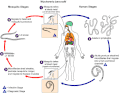Plik:Wuchereria bancrofti LifeCycle.gif
Wuchereria_bancrofti_LifeCycle.gif (513 × 435 pikseli, rozmiar pliku: 33 KB, typ MIME: image/gif)
Historia pliku
Kliknij na datę/czas, aby zobaczyć, jak plik wyglądał w tym czasie.
| Data i czas | Miniatura | Wymiary | Użytkownik | Opis | |
|---|---|---|---|---|---|
| aktualny | 16:15, 5 lis 2008 |  | 513 × 435 (33 KB) | Lycaon | Watermark removed |
| 23:02, 14 maj 2006 |  | 513 × 435 (36 KB) | Patho | {{Information| |Description=Filariasis [Brugia malayi] [Brugia timori] [Loa loa] [Mansonella ozzardi] [Mansonella perstans] [Mansonella streptocerca] [Onchocerca volvulus] [Wuchereria bancrofti] Life cycle of Wuchereria bancrofti Different species |
Lokalne wykorzystanie pliku
Poniższa strona korzysta z tego pliku:
Globalne wykorzystanie pliku
Ten plik jest wykorzystywany także w innych projektach wiki:
- Wykorzystanie na ceb.wikipedia.org
- Wykorzystanie na de.wikipedia.org
- Wykorzystanie na de.wikibooks.org
- Wykorzystanie na en.wikipedia.org
- Wykorzystanie na fr.wikipedia.org
- Wykorzystanie na hu.wikibooks.org
- Wykorzystanie na nn.wikipedia.org
- Wykorzystanie na sv.wikipedia.org

